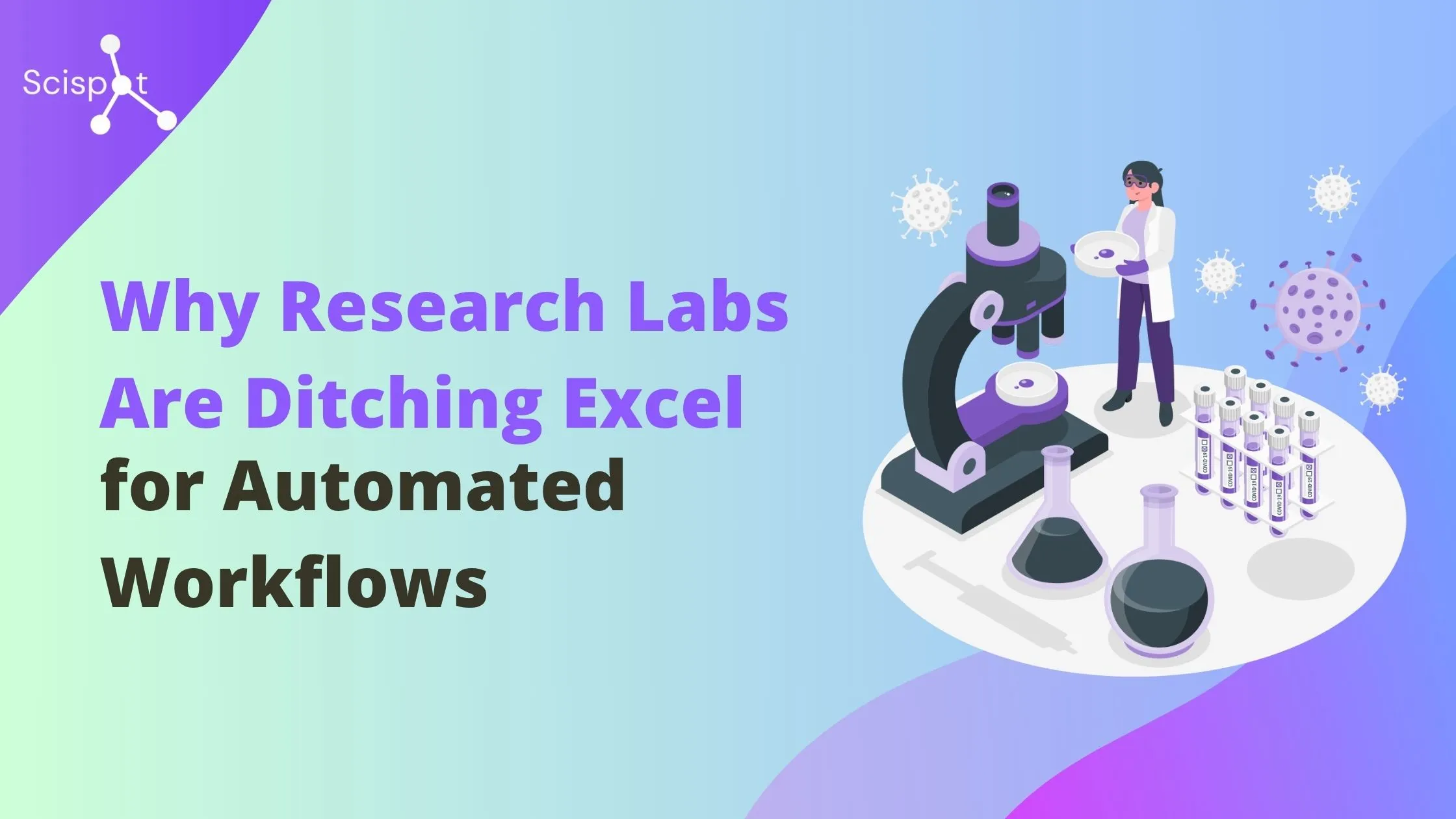Modern biotech labs face a critical challenge: transforming raw instrument data into actionable insights while maintaining data quality and operational efficiency. The widespread reliance on manual processes like copy-pasting values into Excel spreadsheets is holding back scientific innovation and creating unnecessary bottlenecks in lab workflows.
This guide explores practical strategies for automating lab data management and building robust, future-ready data infrastructures that support both current operations and future AI-driven analytics.
The Hidden Costs of Manual Data Transfer
Most biotech labs still depend on manual intervention for data transfers between high-throughput instruments and digital repositories. This outdated approach creates several problems that compound over time.
Manual data handling compromises data quality through human error and introduces operational inefficiencies that slow down research timelines. Labs struggle with delays, lost data, and inconsistent formatting, which collectively impede effective analysis and decision-making processes.
The time researchers spend on data entry could be better allocated to actual scientific work. When lab teams manually transfer data between systems, they're essentially performing tasks that modern lab automation software can handle more accurately and efficiently.

Integration Challenges Across Diverse Lab Instruments
The vast diversity of laboratory instruments presents unique integration challenges. Each device often comes with proprietary file formats and interfaces, creating severe bottlenecks when trying to consolidate data from multiple sources.
Conventional, one-size-fits-all solutions rarely work effectively when reconciling data from sources ranging from raw binary outputs to richly formatted text files. This diversity makes it challenging for laboratories to streamline data processes and achieve efficient data integration across their operations.
Modern labs need flexible solutions that can adapt to various data formats while maintaining consistency and reliability across different instrument types and manufacturers.
The Missing Standard: Why Labs Need Universal Data Connectivity
Research labs currently lack standardized data protocols similar to universal connectivity standards in other industries. This absence of standardization forces labs to rely on custom middleware solutions to bridge connectivity gaps.
While functional in the short term, these custom solutions increase system complexity and operational costs over time. LIMS integration becomes more difficult when each instrument requires its own custom connection approach.
Standardizing connectivity approaches is essential for efficient, cost-effective data integration that can scale with growing lab operations and evolving technology requirements.
Regulatory Compliance in Automated Data Systems
In regulated industries, stringent security protocols mandate consistent data transfer, storage, and auditing procedures to ensure compliance and maintain trust. The reliance on disconnected solutions to manage data transfers between high-throughput instruments and systems like Electronic Lab Notebooks creates compliance risks.
Comprehensive protocol adoption for lab data management ensures data integrity while meeting regulatory requirements. Automated systems with built-in compliance features can actually improve audit readiness compared to manual processes.
Scispot's alt-ELN provides built-in compliance features that help labs maintain audit-ready documentation while automating data workflows.

API-Driven Solutions Transform Lab Operations
There's growing demand for API solutions and middleware that enable seamless integration between disparate lab instruments and centralized data processing platforms. These solutions reduce reliance on manual intervention and standardize data connectivity across various instruments and platforms.
By adopting API-driven approaches, labs can move toward more streamlined, efficient, and scalable data pipelines prepared to handle future analysis requirements. These solutions support integration of legacy systems alongside emerging technologies, creating a cohesive digital ecosystem.
Lab automation software with robust API capabilities allows labs to connect instruments, databases, and applications without requiring extensive custom development work.
Balancing Automation with Human Oversight
Successful lab data management requires incorporating human oversight to maintain quality control and ensure reliable outputs. Automation should complement expert knowledge rather than replace it entirely.
Scientific experts need to maintain oversight capabilities to prevent and address anomalies while ensuring high standards of data accuracy. The most effective systems provide automated efficiency with built-in checkpoints for human review.
Scispot's GLUE platform exemplifies this approach by providing automated data integration with configurable quality control checkpoints that maintain human oversight where needed.
Vendor Solutions vs. Custom Development
Vendor-provided solutions offer flexible and modular integration capabilities that can alleviate the heavy resource burden on in-house teams. This approach allows scientific experts to focus on core research rather than building custom data pipelines.
Modular integration solutions provide the flexibility to adapt to changing requirements while maintaining system reliability and reducing long-term maintenance overhead. These solutions typically offer faster implementation compared to custom development approaches.
When evaluating vendor solutions, labs should prioritize platforms that offer both immediate functionality and long-term scalability for growing data requirements.

Building Infrastructure for AI-Ready Labs
The industry is moving toward robust, standardized infrastructures that support both structured and semi-structured data, setting the stage for enhanced machine learning readiness and future AI-driven analytics.
Lab automation software platforms that can handle diverse data types and provide clean, standardized outputs will be essential for labs planning to implement AI and machine learning capabilities in their research workflows.
Future-ready lab data management systems should accommodate current operational needs while providing the flexibility to integrate emerging technologies as they become available.
Scispot AI demonstrates how modern lab platforms can integrate AI capabilities directly into existing workflows, providing intelligent insights without disrupting established processes.
Practical Next Steps for Lab Modernization
Labs considering modernization should start by evaluating their current data transfer processes and identifying the biggest pain points in their existing workflows. This assessment helps prioritize which areas will benefit most from automation.
Consider beginning with pilot implementations that address specific bottlenecks rather than attempting to overhaul entire systems at once. This approach reduces risk while demonstrating clear value from lab automation software investments.
Focus on solutions that offer modular implementation, allowing labs to gradually expand automation capabilities as teams become comfortable with new processes and identify additional optimization opportunities.
Ready to transform your lab's data management approach? Book a demo to see how Scispot can automate your lab workflows and eliminate manual data entry, allowing your team to focus on what matters most: advancing scientific discovery.






.webp)
.webp)
.webp)



